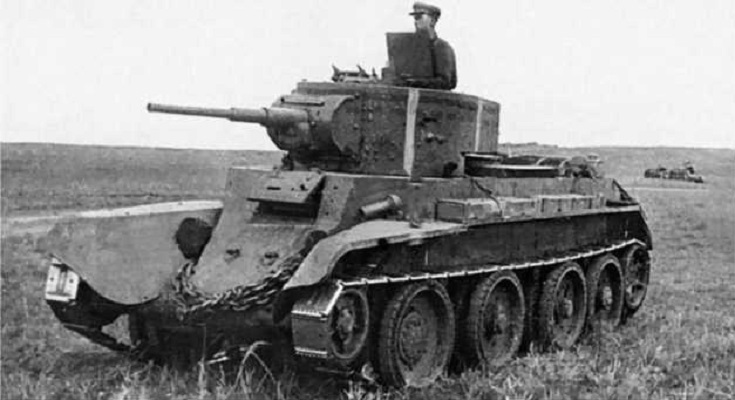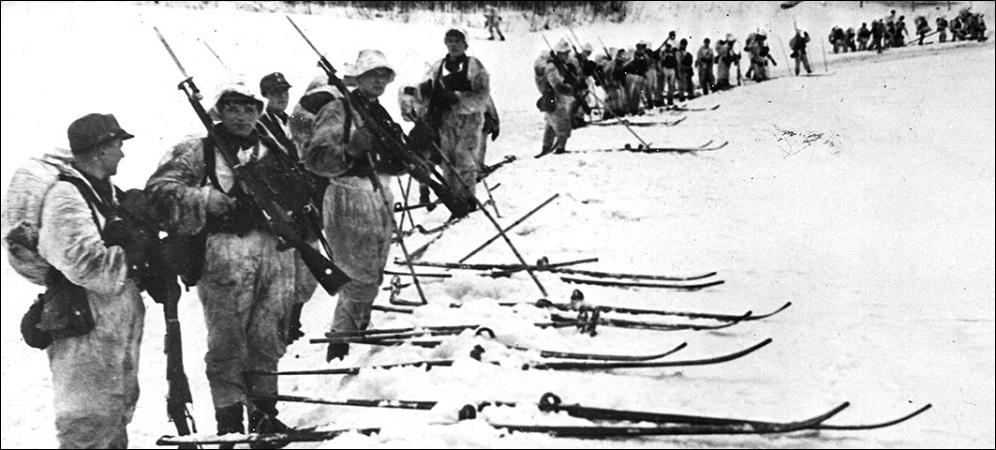● ● ●
In the 1930s the Red Army of
Workers and Peasants—to give it its full official name—was
widely regarded as the most powerful and forward-thinking
army in the world. Years before the first German panzer
division was organized, the Red Army set up a number of
mechanized corps—armored divisions in effect. It was also
first in the field with parachute troops, by 1939 counting
more than a dozen airborne brigades in its order of battle.
The artillery arm had always been the elite corps of the
Russian army and by all appearances this tradition was being
maintained in the Soviet era. All in all, there there seemed
to be a good deal of truth in the official propaganda line:
that the Red Army was incomparably the most advanced and
formidable fighting force in existence.
The Army’s basic unit was the rifle
division, as its infantry divisions were titled. By
comparison with the
German Type 1939 Infantry Division,
the 1939 rifle division’s size and strength were impressive. The
German division had on average 16,000 men, the Soviet
division 18,800. The Soviet division had a light tank
battalion and an antiaircraft battalion; the German division
had neither. The Soviet division’s reconnaissance battalion
was mechanized; the German division’s relied mostly on
horses and bicycles. Overall the rifle division had more
weapons of every category, from light machine guns to
artillery, not to mention a higher level of motorization.
Or so it appeared from a comparison
of tables of organization and equipment (TOE). But the
reality was quite different. Owing to a shortage of motor
vehicles, many rifle division had largely to rely on
horse-drawn transport. Many of the weapons called for in the
TOE were either short or absent or obsolete models. And in
the divisional units requiring trained technical
specialists—artillery, engineers, signals—there were many
critical personnel shortages.

A BT-7 light tank of the Red Army, late
1930s (Imperial War Museum)
Worse still was the shortage of
competent unit commanders and qualified staff officers, a
class of personnel that the German Army possessed in plenty.
But the Red Army did not, and this was due not so much to
the USSR’s backwardness as to the nature of the Soviet
regime. In 1937-38 Stalin had carried out a purge of the Red
Army high command and officer corps, “repressing” more than
30,000 officers, from marshals of the Soviet Union to
battalion commanders. Supposedly the officer corps was shot
through with treason and sedition, but this was a lie.
For Stalin and his cronies the
political reliability of the Red Army was the paramount
consideration. It was not a new issue with them. In its
early years, during the Civil War, the Army’s leadership
cadres included many former tsarist officers. These men with
their military knowledge and experience were essential to
the Army’s efficiency. But they were never trusted and when
their services were not longer required many were purged.
The Party’s distrust of the Army lingered, however, and the
latter was subjected to close political supervision. All
formations, down to company level, had assigned to them
commissars—political officers—whose task was twofold. They
were responsible for the political indoctrination of of the rank
and file, and for the political supervision of commanders and staffs. In the rifle division headquarters,
for example, the political section consisted of eleven
commissars. All orders of the division commander had to be
countersigned by the chief commissar.
Effective military leadership at a high level demands
breadth of vision and a certain independence of thought. But
just such traits excited Stalin’s suspicion: Broad vision
and independence of thought might not be restricted to the
military sphere. They might, indeed, lead to sedition. Thus
the high command of the Red Army, headed by Marshal of the
Soviet Union Marshal Mikhail Tukhachevsky, a farsighted
military reformer, had to go. And thus the officer corps as
a whole had to be ideologically purified—meaning in practice
that political reliability must trump military
professionalism. The pretext for this purge was the
(fictional) Trotskyist Anti-Soviet
Military Organization, supposedly a cabal of treasonous
senior officers. These men, seven in number with
Tukhachevsky at their head, were arrested, brutally
interrogated to extort confessions, put through the form of
a trial, convinced and shot on the night of 11-12 June 1937.
Subsequently 37,761 officers and Red Army commissars were
dismissed from the service, 10,868 being arrested and 7,211
condemned to death or the Gulag for crimes against the
state. Their replacements, promoted from the lower ranks,
mostly lacked the necessary professional military education
and training. This was to have baneful consequences.

The Red Army's redoubtable opponent:
Finnish infantry during the Winter War (World War Photos)
The
deficiencies stemming from the Red Army's equipment and
personnel shortages, exacerbated by poor leadership thanks
to the ravages of the purge, were exposed in the course of
the 1939-40 Winter War with Finland. Stalin’s crony, Marshal Kliment Voroshilov, then serving as People’s Commissar of
Defense, assured the Soviet leader that the Finnish Army
would be vanquished in a matter of weeks. It didn't turn out
that way. The theater of operations had few roads and was
heavily forested, with numerous lakes, rivers and swamps,
and the Chief of Staff, General Boris Mikhaylovich
Shaposhnikov, advised that a winter campaign in Finland
would be a difficult undertaking. His advice was ignored,
Stalin accepting Voroshilov’s view that sheer weight of
numbers would guarantee a quick victory.
The invasion was launched on 30
November 1939 and almost immediately ran into trouble. On
the Karelian Isthmus north of Leningrad, six Finnish infantry divisions
repelled
repeated Soviet attacks, inflicting heavy casualties. In
central and north Finland, several Red Army divisions were
encircled and destroyed. Here the Finns, well trained in
winter warfare, employed guerrilla tactics to split up the
road-bound enemy formations into small groups and liquidate
them. Though its soldiers fought
stubbornly on most occasions the Red Army's
deficiencies—poor leadership and training, inadequate
logistical support—were painfully exposed in battle against
a smaller but well trained and skillfully commanded
opponent.
Numerical superiority eventually enabled the invaders
eventually to prevail, but not before the Finns had
inflicted a series of stinging defeats on the supposedly
invincible Red Army. It was estimated that Red Army
casualties in the Winter War—killed, wounded, missing in
action—totaled nearly 400,000, as against some 70,000 total
Finnish casualties. Tank losses totaled 1,200. Stalin took
alarm at this and various reforms were immediately set in
motion, but they barely had time to take effect before
Hitler launched his invasion of the USSR on 22 June 1941.
● ● ●